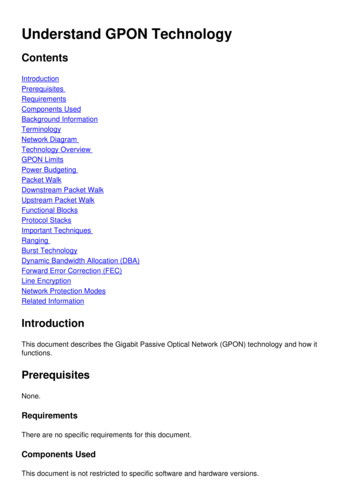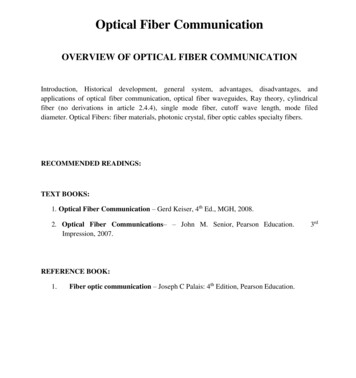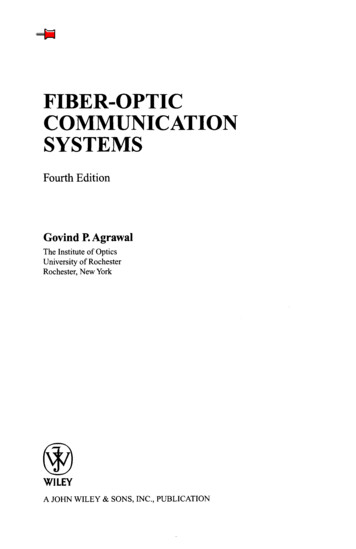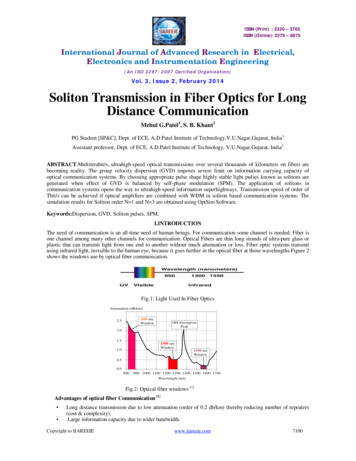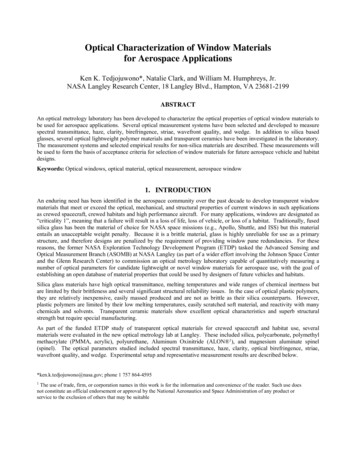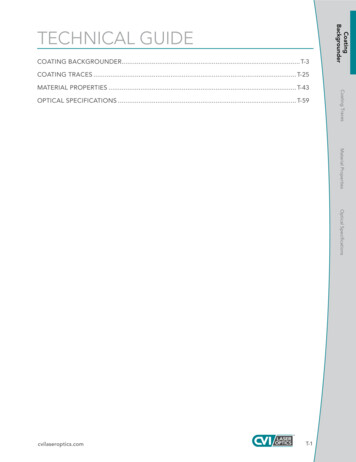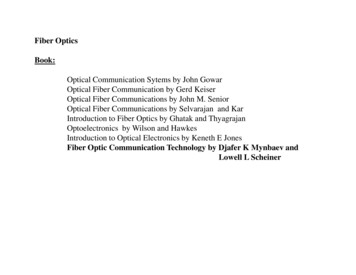
Transcription
Fiber OpticsBook:Optical Communication Sytems by John GowarOptical Fiber Communication by Gerd KeiserOptical Fiber Communications by John M. SeniorOptical Fiber Communications by Selvarajan and KarIntroduction to Fiber Optics by Ghatak and ThyagrajanOptoelectronics by Wilson and HawkesIntroduction to Optical Electronics by Keneth E JonesFiber Optic Communication Technology by Djafer K Mynbaev andLowell L Scheiner
TAT-8 (Eighth Trans Atlantic under sea fiber optics Link between New Jersy (USA)to France (Europe)TAT-7 link Predecessor of TAT-8 based on metal cables carried 5000 voicechannels whereas TAT-8 carried 37800 channels.
An optical fiber (or fibre) is a glass or plastic fiber that carries light along itslength.An optical fiber is a cylindrical dielectric waveguide (nonconductingwaveguide) that transmits light along its axis, by the process of total internalreflection. The fiber consists of a core surrounded by a cladding layer, bothof which are made of dielectric materials. To confine the optical signal in thecore, the refractive index of the core must be greater than that of thecladding. The boundary between the core and cladding may either beabrupt, in step-index fiber, or gradual, in graded-index fiber.
Total internal reflectionWhen light traveling in a dense medium hits a boundary at a steep angle (largerthan the "critical angle" for the boundary), the light will be completely reflected.This effect is used in optical fibers to confine light in the core. Light travels alongthe fiber bouncing back and forth off of the boundary.Because the light must strike the boundary with an angle greater than the criticalangle, only light that enters the fiber within a certain range of angles can traveldown the fiber without leaking out.This range of angles is called the acceptance cone of the fiber. The size of thisacceptance cone is a function of the refractive index difference between thefiber's core and cladding.In simpler terms, there is a maximum angle from the fiber axis at which light mayenter the fiber so that it will propagate, or travel, in the core of the fiber.The sine of this maximum angle is the numerical aperture (NA) of the fiber.Fiber with a larger NA requires less precision to splice and work with than fiberwith a smaller NA. Single-mode fiber has a small NA.
Modal Dispersion
Fiber Types
Step Index Multi-Mode cable has a little bit bigger diameter, with a commondiameters in the 50-to-100 micron range for the light carry component (themost common size is 62.5um). POF is a newer plastic-based cable whichpromises performance similar to glass cable on very short runs, but at a lowercost. Multimode fiber gives high bandwidth at high speeds (10 to 100MBS Gigabit to 275m to 2km) over medium distances.Light waves are dispersed into numerous paths, or modes, as they travelthrough the cable's core typically 850 or 1300nm. Typical multimode fibercore diameters are 50, 62.5, and 100 micrometers. However, over long runsmultiple paths of light can cause signal distortion at the receiving end,resulting in an unclear and incomplete data transmission so designers nowuse single mode fiber in new applications using Gigabit and beyond.
GRADED-INDEX MULTIMODE FIBER contains a core in which the refractiveindex diminishes gradually from the center axis out toward the cladding. Thehigher refractive index at the center makes the light rays moving down the axisadvance more slowly than those near the cladding. Also, rather than zigzaggingoff the cladding, light in the core curves helically because of the graded index,reducing its travel distance. The shortened path and the higher speed allowlight at the periphery to arrive at a receiver at about the same time as the slowbut straight rays in the core axis. The result: a digital pulse suffers lessdispersion.
SINGLE-MODE FIBER has a narrow core (8-10 microns), and the index ofrefraction between the core and the cladding changes less than it does formultimode fibers. Light thus travels parallel to the axis, creating little pulsedispersion. It is a relatively narrow diameter, through which only one modepropagate typically 1310 or 1550nm. Synonyms mono-mode optical fiber,single-mode fiber, single-mode optical waveguide, uni-mode fiber.
Distribution Cables
Losses due to macrobendingLosses due to microbending
Fiber MaterialsTwo main type of materials are there for making optical fibers.1. Plastics FibersThe plastics offers advantages in terms of cost, ease of fabrication and have highmechanical flexibility. They have high transmission losses and are often useful forshort distance communication.Polystyrene core (refractive index 1.6) and Polymethylmethaacrylate (PMMA)cladding (refractive index 1.49) NA 0.583 and acceptance angle 35.66 deg.Polymethylmethaacrylate core (refractive index 1.49) and Polymer cladding(refractive index 1.40) NA 0.51 and acceptance angle 30.66 degrees.2. Glasses FibersMainly two types of glass fibers are there based on the(i) Silica glass (SiO2)(ii) Soft glasses such as Sodium borosilicates, Sodium calcium silicates,and Lead silicates. These are high purity low loss optical fibers.
Obvious requirement of the material is that it must be possible to vary therefractive index by addition of other impurities.Pure Silica has refractive index 1.46 at 1 micron.Other dopants like (Fluorine, Boron, Phosphorus, Germanium, Aluminium andTitanium are added to it to change its refractive index.Glass fibers can be made with a relatively wide range of refractive index but thecontrol of impurity content is more difficult than with silica where it can becontrolled up to 1ppb level.
Fiber Fabrication MethodsAmong the various fabrication techniques there are two methods used formaking low loss optical fibers.Double Crucible MethodChemical Vapour Deposition Techniques
Double Crucible MethodPure glass material with appropriate dopants is taken in two platinum crucibles. At thebottom of each crucibles is a circular nozzle, both being concentric, the inner nozzleis slightly above the outer one.The inner crucible contains core material and the outer one contains claddingmaterial. The two crucibles are kept inside the furnace which is heated to hightemperature. When the temperature of the furnace is raised sufficiently high byswitching on the heating power, the core material flows through the inner nozzle intothe center of the flow stream of the outer crucible.The fiber is then allowed to pass through a bath containing molten plastic forprotective coating of plastic over the fiber. Below this is curing oven and then arotating take up drum on which composite fiber is wound onto it.If the two materials remain separated then step index fiber will result. By usingglasses that diffuses (or by having dopants that do so) graded index fiber can beobtained. The index profile can be controlled by diffusion process.
Standard optical fibers are made by first constructing a large-diameterpreform, with a carefully controlled refractive index profile, and then pullingthe preform to form the long, thin optical fiber.The preform is commonly made by chemical vapor deposition methods:inside vapor deposition, outside vapor deposition
Chemical Vapour Deposition TechniquesIt is one of the variety of vapour phase deposition techniques, that produces fibershaving minimal impurity content. In this techniques a doped silica layer isdeposited onto the inner surface of a pure silica tube. The deposition occurs as aresult of a chemical reaction taking place between the vapour constituents that arebeing passed through the tube. Typical vapours used are SiCl4, GeCl4, BCl3,SiF4, TiCl4, etc. and the various reactions that may takes place may be written asfollows:SiCl4 O2 SiO2 2Cl2GeCl4 O2 GeO2 2Cl2SiF4 O2 SiO2 2F2TiCl4 O2 TiO2 2Cl24BCl3 3O2 2B2O3 6Cl24POCl3 3O2 2P2O5 6Cl2
The zone where reaction takes place is moved along the tube by locally heatingthe tube to the temperature in the range 1200-1600C with a travelling oxyhydrogen flame as shown in figure. If the process is repeated with differentinput concentrations of the dopant vapours, the layers of different impurityconcentrations may be built up sequentially. This technique thus allows thefabrication of graded index fiber with much greater control over the indexprofiles than does the double crucible method.After the deposition process is complete, the tube is heated to its softeningtemperature ( 2000ºC). The tube then collapses into a solid rod called perform.The fiber is subsequently produced by drawing from the heated tip of theperform as it is lowered into a furnace. To have finite control over the fiberdiameter, a thickness monitoring gauge is used before the fiber is drawn ontothe take up drum and feedback is applied to the take up drum speed.Similar to earlier method a protective plastic coating is often applied to theoutside of the fiber and resulting coating is then cured bypassing it through afurther furnace.
Modifiedchemicalvapourdeposition(inside)process
The preform, however constructed, is then placed in a device knownas a drawing tower, where the preform tip is heated and the opticfiber is pulled out as a string. By measuring the resultant fiber width,the tension on the fiber can be controlled to maintain the fiberthickness.Fiber optic coatings are UV-cured urethane acrylate compositematerials applied to the outside of the fiber during the drawingprocess. The coatings protect the very delicate strands of glass fiber—about the size of a human hair—and allow it to survive the rigors ofmanufacturing, proof testing, cabling and installation.
The core and cladding material isdeposited inside tubeFurther heating collapses the tubeFiber wire drawing
Fusion Splicer
Splice alignment structures
Elastomeric mechanical splices
Multiple fiber splicing
Sources for Optical FibersLaser diode
REPEATERSAs was mentioned earlier, even though modern optical fibers are extremelytransparent, attenuation of the intensity of the light traveling along the fiberstill occurs, and over long distances the light signal must be boosted backto a larger value. This process was traditionally carried out with a repeater.This is a device incorporating a light detector, processing electronics, and anew laser. An incoming stream of optical pulses, corresponding to thetransmitted information in binary code, is detected and becomes anequivalent stream of electrical pulses. These electrical pulses areamplified, reshaped electronically to restore their original shape, and arethen used to drive the new laser to re-transmit the information along thenext stretch of fiber. In this way, a stream of optical pulses can betransmitted over great distances, such as under the Atlantic Ocean, byspacing a series of repeaters along the fiber cable. Typically repeaters arespaced every 45-70 km. Consequently, a long fiber cable must incorporateconventional electrical wires to provide the power to drive the repeaters.
An optical fiber is a cylindrical dielectric waveguide (nonconducting essof totalinternal reflection .Thefiberconsistsofacore surroundedbyacladding layer,both ofwhicharemadeof dielectric materials.Toconfinetheopticalsignalinthe core, the refractive index of the core must be greater than that of t.


